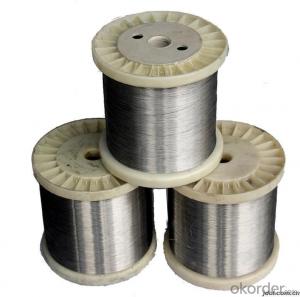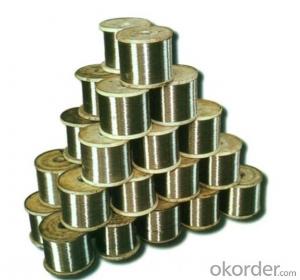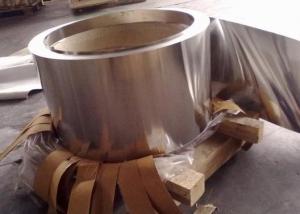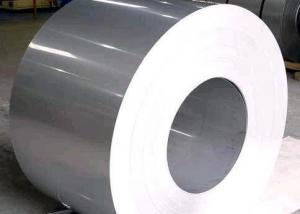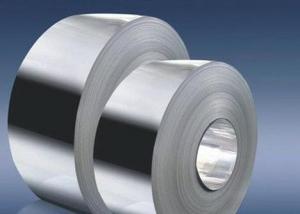stainless steel wire rope for building industry
- Loading Port:
- Qingdao
- Payment Terms:
- TT OR LC
- Min Order Qty:
- 1 m.t.
- Supply Capability:
- 1000 m.t./month
OKorder Service Pledge
Quality Product, Order Online Tracking, Timely Delivery
OKorder Financial Service
Credit Rating, Credit Services, Credit Purchasing
You Might Also Like
hot selling 8x19 stainless steel wire rope
1:Description
| Product Detail | |
| Wire diameter | 0.03mm-2.0mm |
| Grade | 200 series,300 series,400 series |
| Standard | ASTM,EN. DIN,JIS |
| Surface | Bright,Cloudy,Plain, Black, as your request |
| Type | Spring, Welded,Tig,Migetc soft and hard |
| Tensile Strength | 630N/mm2 —900N/mm2 |
| Production Process |
|
| Packing | Plastic film inside and woven bag or hession cloth outside ,25kg/50kg each coil ,25ton/20'' FCL |
| Features |
|
- Q:What are the different types of stainless steel wire ropes used in sports equipment?
- There are several different types of stainless steel wire ropes used in sports equipment, each with its own unique characteristics and advantages. 1. 1x19 Construction: This type of wire rope consists of 19 individual strands twisted together, forming a strong and stiff cable. It is commonly used in applications that require high strength and minimal flexibility, such as rigging for sailboats or cable barriers in sports facilities. 2. 7x7 Construction: This wire rope is made up of seven strands, each consisting of seven wires. It offers good flexibility and moderate strength, making it suitable for use in sports equipment like gymnasium cable systems, zip lines, and suspension bridges. 3. 6x19 Construction: This type of wire rope has a flexible construction consisting of six strands, with each strand containing 19 wires. It provides excellent flexibility and high strength, making it ideal for use in applications such as winch lines, wire slings, and cable assemblies in sports equipment like rock climbing gear and aerial acrobatics. 4. 7x19 Construction: This wire rope is made up of seven strands, each consisting of 19 wires. It offers good flexibility, high strength, and resistance to abrasion, making it suitable for use in sports equipment such as gymnasium cable systems, exercise machine cables, and suspension cables for outdoor adventure courses. 5. 6x36 Construction: This type of wire rope is made up of six strands, each consisting of 36 wires. It offers high flexibility and excellent resistance to fatigue, making it suitable for use in applications that require repeated bending and flexing, such as wire rope slings, cable winches, and overhead lifting systems used in sports equipment like weightlifting machines and cranes. It's important to note that the selection of the appropriate type of stainless steel wire rope for sports equipment depends on factors such as the desired strength, flexibility, resistance to corrosion, and specific requirements of the equipment or application in question.
- Q:What is stainless steel wire made from?
- Stainless steel wire is primarily made from an alloy of iron, chromium, and sometimes other elements such as nickel or manganese. This alloy is known for its exceptional resistance to corrosion and rust, making it an ideal material for applications where durability and hygiene are crucial. The specific composition of the stainless steel wire can vary depending on the desired properties and intended use. The addition of chromium forms a protective layer of chromium oxide on the surface of the wire, acting as a barrier against moisture and preventing oxidation. This results in a wire that is highly resistant to staining, rust, and corrosion, making it suitable for various industries including construction, automotive, medical, and food processing. Additionally, stainless steel wire can be further processed through various techniques such as drawing, annealing, or coating to achieve specific mechanical properties or surface finishes. The versatility and strength of stainless steel wire have made it a popular choice in numerous applications where strength, corrosion resistance, and aesthetic appeal are essential.
- Q:Can stainless steel wire be used for wire rope pulleys?
- Yes, stainless steel wire can be used for wire rope pulleys. Stainless steel is a strong and durable material that offers excellent resistance to corrosion, making it suitable for outdoor or marine applications. It has a high tensile strength and can withstand heavy loads and constant use. Stainless steel wire rope pulleys are often used in industries such as construction, mining, and transportation where reliability and longevity are required.
- Q:What are the different types of stainless steel wire used for safety wire?
- There are several different types of stainless steel wire that are commonly used for safety wire applications. These include: 1. Type 302/304: This is the most common type of stainless steel wire used for safety wire. It is a general-purpose stainless steel that provides good strength and corrosion resistance. It is suitable for a wide range of applications and is commonly used in aerospace and automotive industries. 2. Type 316: This type of stainless steel wire is known for its superior corrosion resistance, especially in environments where there is exposure to saltwater or other corrosive elements. It is often used in marine applications or in industries where high levels of corrosion resistance are required. 3. Type 17-7 PH: This is a precipitation-hardening stainless steel wire that offers excellent strength, along with good corrosion resistance. It is often used in high-stress applications or in situations where higher strength is required, such as in aircraft. 4. Type 321: This stainless steel wire is stabilized with titanium, which makes it highly resistant to intergranular corrosion. It is often used in applications where elevated temperatures are present, such as in exhaust systems or high-temperature environments. 5. Type 430: While not as commonly used for safety wire, type 430 stainless steel wire offers good corrosion resistance and is often used in applications where there is exposure to mild corrosive elements. Overall, the choice of stainless steel wire for safety wire applications depends on the specific requirements of the application, such as strength, corrosion resistance, and temperature resistance. It is important to select the appropriate type of stainless steel wire to ensure the safety and reliability of the wire's performance.
- Q:How is stainless steel wire mesh woven?
- Stainless steel wire mesh is woven using a process called plain weave or twill weave. In the plain weave method, the wires are woven in a crisscross pattern, with each wire passing over and under the adjacent wires in an alternating manner. This creates a simple and tight mesh structure. On the other hand, in the twill weave method, the wires are interlaced in a diagonal pattern, which gives the mesh a more robust and durable construction. This weaving technique involves each wire passing over two and under two adjacent wires, creating a distinctive diagonal pattern. Both plain weave and twill weave methods require precision and attention to detail to ensure a consistent and uniform mesh structure. The wires used in stainless steel wire mesh are usually thin and strong, allowing for a tightly woven and reliable mesh that is resistant to corrosion and wear. Overall, the process of weaving stainless steel wire mesh involves interlacing thin stainless steel wires in either a crisscross or diagonal pattern, resulting in a versatile and durable mesh that finds applications in various industries such as filtration, screening, and protection.
- Q:Are there any safety concerns when handling stainless steel wire?
- Handling stainless steel wire comes with certain safety concerns. Firstly, it is essential to handle it with care as it has sharp edges that can easily cause cuts or puncture wounds. Wearing protective gloves is crucial to prevent any injuries. Secondly, incorrect handling of stainless steel wire can lead to strain or muscle fatigue. It is important to use proper lifting techniques and avoid overexertion, especially when dealing with heavy or large quantities of the wire. In addition, stainless steel wire can become extremely hot during heating or certain manufacturing processes. To avoid burns or thermal injuries, it is necessary to use heat-resistant gloves when handling it. Moreover, individuals with allergies or sensitivities to nickel should take precautions as stainless steel wire may contain small amounts of this metal. Wearing gloves or using barriers to prevent direct contact with the wire is recommended for those with known nickel allergies. Lastly, there is a risk of eye injuries when working with stainless steel wire, as flying particles or sparks can pose hazards. Protecting the eyes by wearing safety glasses or goggles is essential in such situations. In conclusion, while stainless steel wire is generally safe to handle, it is important to be aware of these safety concerns and take necessary precautions to minimize the risk of accidents or injuries.
- Q:Is stainless steel wire resistant to wear and tear?
- Yes, stainless steel wire is highly resistant to wear and tear. Stainless steel is known for its exceptional strength and durability, making it a popular choice for various applications. The alloying elements in stainless steel, such as chromium and nickel, enhance its corrosion resistance and make it resistant to rust, oxidation, and staining. Additionally, stainless steel wire is highly resilient and can withstand heavy loads, bending, and twisting without losing its shape or strength. This inherent resistance to wear and tear makes stainless steel wire suitable for a wide range of industries, including construction, automotive, aerospace, and marine, where it is commonly used in cables, springs, mesh, and other demanding applications.
- Q:What is the difference between stainless steel plate, matte surface and wire drawing surface?
- Stainless steel plate, drawing surface is one of the frosted surface, matte surface basically has SB, HL (wire drawing), NO.4 (snow) these three surfaces.
- Q:Talking about the difference between mirror stainless steel and brushed stainless steel
- Brushed stainless steel is also a way of processing stainless steel, the surface has a trace of texture,.Mirror stainless steel words and brushed stainless steel characters are stainless steel, but the surface effect is not the same.
- Q:Can stainless steel screws be operated by an automatic lock screw machine?
- The automatic lock screw machine has no special requirement for the material of the screw, and the general screw or the stainless steel screw can be used.
1. Manufacturer Overview |
|
|---|---|
| Location | |
| Year Established | |
| Annual Output Value | |
| Main Markets | |
| Company Certifications | |
2. Manufacturer Certificates |
|
|---|---|
| a) Certification Name | |
| Range | |
| Reference | |
| Validity Period | |
3. Manufacturer Capability |
|
|---|---|
| a)Trade Capacity | |
| Nearest Port | |
| Export Percentage | |
| No.of Employees in Trade Department | |
| Language Spoken: | |
| b)Factory Information | |
| Factory Size: | |
| No. of Production Lines | |
| Contract Manufacturing | |
| Product Price Range | |
Send your message to us
stainless steel wire rope for building industry
- Loading Port:
- Qingdao
- Payment Terms:
- TT OR LC
- Min Order Qty:
- 1 m.t.
- Supply Capability:
- 1000 m.t./month
OKorder Service Pledge
Quality Product, Order Online Tracking, Timely Delivery
OKorder Financial Service
Credit Rating, Credit Services, Credit Purchasing
Similar products
New products
Hot products
Hot Searches
Related keywords
